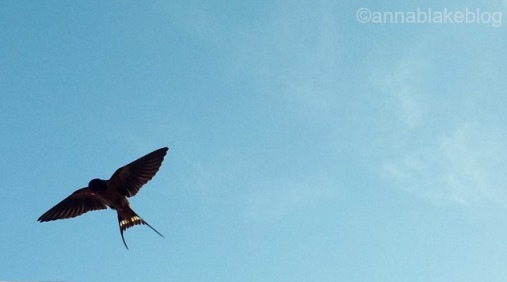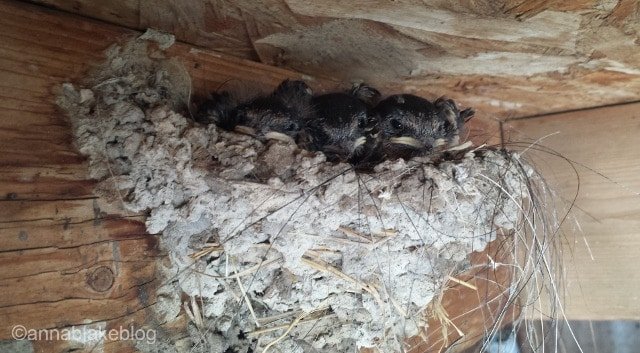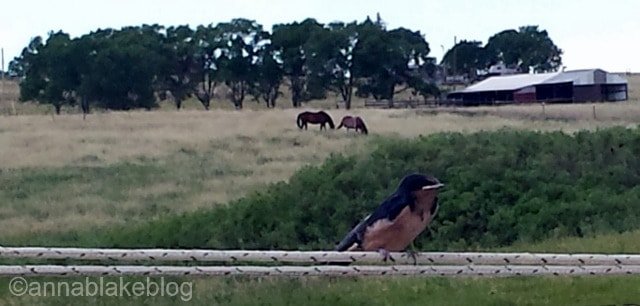 I feel sorry for people who don’t muck. How do they organize their thoughts? Or come up with creative training options? Or share peace of heart with the herd?
I feel sorry for people who don’t muck. How do they organize their thoughts? Or come up with creative training options? Or share peace of heart with the herd?
This time of the year the barn swallows are very busy. They might be my favorite bird. There is some serious competition over on the pond; I have to love the hawks as they hang motionless in the air, watching my farm and giving a plaintive call to the prairie. The pond is totally alive with chatter. There’s always a quackle of ducks with tails up in the air. Herons stalk the edge, stiff with tradition. They keep wary distance and are timeless when airborne, looking just like pterodactyls.
Each spring Canada geese march around my pond, stretching their necks tall, checking the neighborhood to see if we are a worthy nest area. We had never passed the test, but this year a mated pair hatched four eggs. The goslings all survived and are teen-aged now. Their markings make them look over-dressed but then Canada Geese have always been more formal.
I like barn swallows because they have one wing in both worlds: they are wild birds who chose to live with domestic animals. Like mice and rabbits, they appreciate sharing the barn with horses and goats. But it isn’t just affection with us, it’s an exchange of goods and services. They barter the rent on a rafter with active insect control.
Barn swallows are a little fancier than they need to be. Their body angles look like live sumi brush paintings. They disdain everyday brown feathers for a sophisticated color choice: a shiny midnight blue back and wings, and an dapper apricot-colored vest. Long fringe tail feathers on the males seem impractical for daily barn chores, but they are fanatic workers and committed parents.
I get a lot of close-up time with the barn swallows while mucking. The first nest was in the big barn was over the hay with a clear shot at the door, safe and practical. Then the next year they built a nest in the smaller barn but they didn’t even put eggs in that one. Finally two years ago they worked to build a perfect nest of mud and horse tail hair, cemented to an eave above the Grandfather Horse’s run. They rest on the pipe panels and seem to prefer his company. Who can blame them?
 Once the hatch-lings are all un-shelled, their bright yellow rubbery-rimmed beaks are wider than their heads. They are that ready to eat and the parents frantically rush to feed them. Swallows are insectivores who fly as much as 600 miles a day feeding their young. Soon the parents both looked worse for the wear; skinny and a bit flapped out.
Once the hatch-lings are all un-shelled, their bright yellow rubbery-rimmed beaks are wider than their heads. They are that ready to eat and the parents frantically rush to feed them. Swallows are insectivores who fly as much as 600 miles a day feeding their young. Soon the parents both looked worse for the wear; skinny and a bit flapped out.
The babies peer over the side of the nest with their noggins all in a row. As the fledgelings near leaving the nest, the parent’s swooping attacks become frequent and furious toward anyone coming near the barn. It might work against them: As the parents are frantically trying to keep the babies safe, it’s that same frantic activity that alerts us that the babies will be out soon.
The parents are hyper-protective, dive bombing all intruders who might pose a threat. A high percentage of these babies survive, the diligent parenting works. Flying like tiny fighter jets, they make strafing runs over my barn cats.
Since mouse season is in full swing, the cats are coming and going from the barn like factory workers with their wiggling time cards clenched in their teeth, on the way to the picnic table under the tree which everyone agrees is the best place for tormenting mice. The cats pretend to ignore the birds who have no more meat on them than a moth.
Soon the day comes that the babies glide out of the nest and follow the parents to the round pen. It’s a perfect flight training field. The adults stand guard while the young fliers flap and glide from one side to the other, getting steadier each hour. The family is all there until the exhausted fledglings return to the nest.
In a day or two the raids stop and I know the babies are steady on the wing. Now the nest is empty but the sky is full. The young ones have a look of their feathers being too big for them but at least they are finally growing into their beaks. Edgar ride Burro and I take a break from mucking to watch them soaring over the pond, sweeping up insects. Do birds feel joy?
They are all air and feathers; gravity has no pull. They soar above and glide below the other birds, and we all watch. Ducks have thick wet webbed feet and the heron’s bony knees that stick out, no matter how tightly they fold them. The Grandfather Horse sleeps in the sun and I linger over my muck. Only sparrows fly like jet propelled kites, with a high-speed flip-change of direction on a whim, coasting the pond surface for tasty bugs. They even eat with just a bit more flair that need be.
Compared to grander birds, swallows are probably no big deal. But I marvel, I envy, I lose time watching the miracle again each year. Why is such a small life yet protected so ferociously? What is the hold these little blue kites have on me?
Free as a bird is the old saying. The horses and I never take it for granted. Liberty.
Anna Blake, Infinity Farm.

You need to be a member of Barnmice Equestrian Social Community to add comments!
Join Barnmice Equestrian Social Community